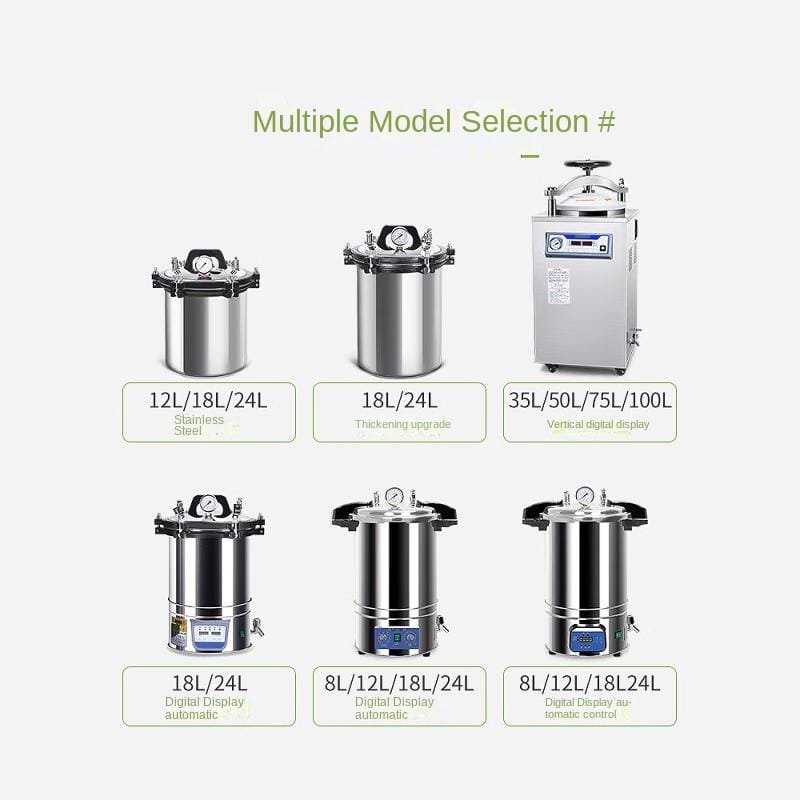

O autoclave é um instrumento vital em vários sectores, como os cuidados de saúde e os laboratórios, para esterilizar ferramentas e materiais. O que é que um autoclave faz? O autoclave funciona através de vapor combinado com pressão e calor para destruir microrganismos, tornando os instrumentos cirúrgicos, o equipamento de laboratório e outros artigos seguros para utilização. **Definir autoclave**: O autoclave funciona como uma câmara selada que produz condições de alta pressão que permitem uma esterilização bem sucedida.
**Como é que um autoclave funciona? O autoclave funciona com base no vapor a níveis de pressão elevados. O aquecimento da água cria vapor que fica retido no interior da câmara. A pressão elevada no interior da câmara do autoclave aumenta o ponto de ebulição da água para produzir vapor que atinge temperaturas suficientes para destruir bactérias, vírus e esporos. Este processo assegura uma esterilização completa.
O método de esterilização em autoclave destaca-se como uma das principais abordagens para esterilizar materiais utilizando calor húmido. A esterilização a vapor elimina os microrganismos expondo-os a vapor de alta temperatura que desnatura as proteínas e rompe as membranas celulares. O vapor infiltra-se nos materiais e a temperatura elevada decompõe as proteínas e rompe as membranas celulares, o que resulta na destruição dos microrganismos. A autoclavagem destaca-se como a melhor abordagem à esterilização por calor húmido porque funciona de forma rápida e fiável sem deixar resíduos químicos.
A gama padrão de temperaturas de esterilização em autoclave vai de 121°C a 134°C. A esterilização eficaz depende do controlo das definições de temperatura e pressão num autoclave. A 121°C, o autoclave mantém um nível de pressão de 15 psi durante um período de 15-20 minutos. Os operadores devem manter um controlo rigoroso das temperaturas de esterilização a vapor para garantir a destruição completa de todos os microrganismos. A esterilização em autoclave deve ocorrer normalmente a 121°C, mas podem ser aplicadas outras temperaturas em situações especiais.
Os autoclaves a vapor representam a categoria mais predominante entre os vários tipos de máquinas de autoclave disponíveis. Os hospitais, laboratórios e instalações de investigação utilizam frequentemente autoclaves a vapor porque proporcionam resultados de esterilização eficientes e fiáveis. A gama de tipos de autoclave abrange tanto autoclaves de deslocamento por gravidade como autoclaves de vácuo, que são concebidos para requisitos de esterilização únicos.
Os hospitais necessitam de autoclaves para esterilizar instrumentos cirúrgicos, bem como batas e equipamento médico. As salas de autoclave dedicadas nos hospitais operam estes dispositivos de esterilização de acordo com diretrizes de segurança rigorosas. Os procedimentos de esterilização protegem os doentes, reduzindo os riscos de infeção.
Que materiais devem ser utilizados para cobrir os artigos antes da autoclavagem? Os artigos recebem proteção contra a contaminação através do acondicionamento em sacos e papel seguros para autoclave. Certifique-se de que as superfícies estão limpas de detritos e material orgânico antes de proceder à autoclavagem. O funcionamento de um autoclave requer a colocação correta dos artigos no seu interior, bem como a definição de níveis precisos de temperatura e pressão antes de verificar a conclusão bem sucedida do ciclo de esterilização.
A combinação de alta temperatura e pressão num esterilizador a vapor elimina todos os microrganismos. **A que temperatura fica um autoclave? As temperaturas normais de funcionamento dos autoclaves variam entre 121°C e 134°C, o que é suficiente para destruir a maioria dos agentes infecciosos. Para a esterilização a temperatura de pressão, o autoclave destaca-se como o instrumento mais eficaz. O autoclave continua a ser a referência da indústria para a esterilização por temperatura de pressão. O esterilizador funciona através do desenvolvimento de condições que erradicam todos os microrganismos para alcançar a segurança total.
Conclusão
Os hospitais, laboratórios e várias indústrias confiam nos autoclaves como instrumentos essenciais para a esterilização. Os utilizadores que compreendem a mecânica operacional de um esterilizador de autoclave, bem como o seu processo de esterilização e os requisitos de temperatura e pressão, podem manter práticas de esterilização seguras e bem sucedidas. O autoclave é a abordagem mais fiável para a destruição microbiana total ao esterilizar instrumentos cirúrgicos ou equipamento de laboratório.

O processo de autoclavagem é uma prática de esterilização essencial utilizada em instalações médicas, laboratoriais e de investigação para proteger o material de vidro e os instrumentos através de uma esterilização eficaz. O vapor de alta pressão elimina os agentes patogénicos durante este

O processo de autoclavagem é uma prática de esterilização essencial utilizada em instalações médicas, laboratoriais e de investigação para proteger o material de vidro e os instrumentos através de uma esterilização eficaz. O vapor de alta pressão elimina os agentes patogénicos durante este
O processo de autoclavagem é uma prática de esterilização essencial utilizada em instalações médicas, laboratoriais e de investigação para proteger o material de vidro e os instrumentos através de uma esterilização eficaz. O vapor de alta pressão elimina os agentes patogénicos durante este
O processo de autoclavagem é uma prática de esterilização essencial utilizada em instalações médicas, laboratoriais e de investigação para proteger o material de vidro e os instrumentos através de uma esterilização eficaz. O vapor de alta pressão elimina os agentes patogénicos durante este
O processo de autoclavagem é uma prática de esterilização essencial utilizada em instalações médicas, laboratoriais e de investigação para proteger o material de vidro e os instrumentos através de uma esterilização eficaz. O vapor de alta pressão elimina os agentes patogénicos durante este
O processo de autoclavagem é uma prática de esterilização essencial utilizada em instalações médicas, laboratoriais e de investigação para proteger o material de vidro e os instrumentos através de uma esterilização eficaz. O vapor de alta pressão elimina os agentes patogénicos durante este